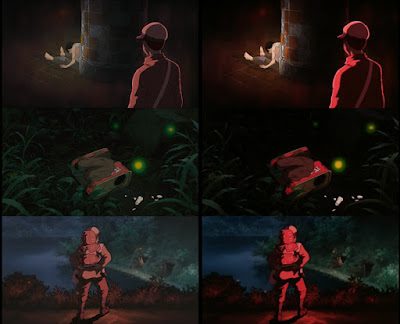Video Essay: The Colors of GRAVE OF THE FIREFLIES from Oswald Iten on Vimeo.
In my opinion, FIREFLIES is a prime example of how naturalistic colors are organized into restricted concepts that help "make the film more easily understood" (to quote character color stylist Yasuda Michiyo). It's also a testament to the collaboration of Yasuda and art director/background painter Yamamoto Nizo.
This color analysis is based on the official Blu ray transfer, i.e. a stellar digital restoration which - for several reasons - may or may not replicate the exact colors of an original 35mm print from 1988.
If you look at the comparison below, it becomes pretty obvious how much detail was lost by pushing saturation and contrast for the earlier DVD transfer. A lot of these "simplifications" may be due to the nature of NTSC which was a color system vastly inferior both to 35mm and high definition.
But the overall impression is also a lot warmer, lumping soft shades of olive and green into reddish browns which works against the overall color schemes.
left: Blu-ray right: NTSC DVD
 | ||
| Dark areas are completely drowned in the old transfer, while subtleties in saturation are also lost. |
One of the reasons I like the film so much lies in the ambivalent but empathetic portrayal of its protagonist. Takahata's film is based on a semi-autobiographical novel by Nosaka Akiyuki who felt responsible for his sister's death during World War II. On the one hand, fourteen year old Seita is repeatedly shown taking care of his sister in the most affectionate way so that we strongly sympathize with the two children. On the other hand however, he also stubbornly refuses to contribute to the community. And it's not just his aunt who accuses him of being lazy, the staging of many a scene suggests the same, as you can see below:







